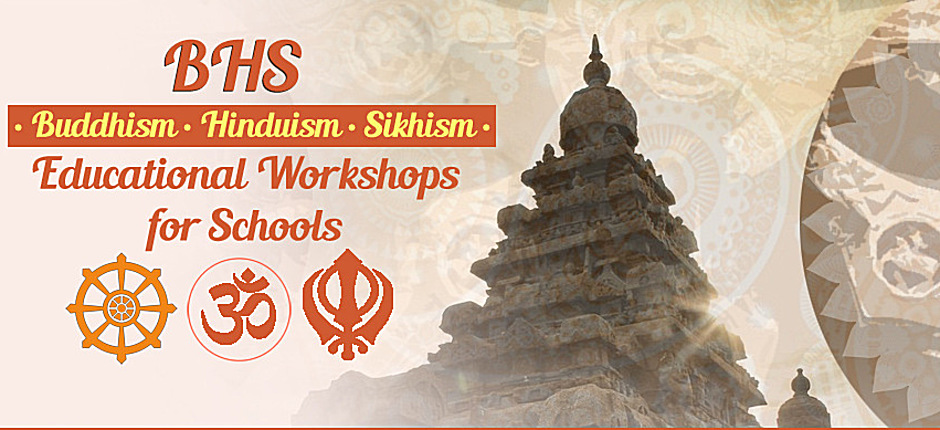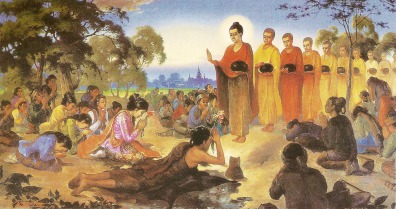Four Noble Truths
"I teach suffering, its origin, cessation and path. That's all I teach", declared the Buddha 2500 years ago.
The Four Noble Truths contain the essence of the Buddha's teachings. It was these four principles that the Buddha came to understand during his meditation under the bodhi tree.
- The truth of suffering (Dukkha)
- The truth of the origin of suffering (Samudāya)
- The truth of the cessation of suffering (Nirodha)
- The truth of the path to the cessation of suffering (Magga)
The Buddha is often compared to a physician. In the first two Noble Truths he diagnosed the problem (suffering) and identified its cause. The third Noble Truth is the realisation that there is a cure.
The fourth Noble Truth, in which the Buddha set out the Eightfold Path, is the prescription, the way to achieve a release from suffering.
The First Noble Truth
Suffering (Dukkha)
Suffering comes in many forms. Three obvious kinds of suffering correspond to the first three
sights the Buddha saw on his first journey outside his palace: old age, sickness and death.
But according to the Buddha, the problem of suffering goes much deeper. Life is not ideal: it frequently fails to live up to our expectations.
Human beings are subject to desires and cravings, but even when we are able to satisfy these desires, the satisfaction is only temporary. Pleasure does not last; or if it does, it becomes monotonous.
Even when we are not suffering from outward causes like illness or bereavement, we are unfulfilled, unsatisfied. This is the truth of suffering.
Some people who encounter this teaching may find it pessimistic. Buddhists find it neither optimistic nor pessimistic, but realistic. Fortunately the Buddha's teachings do not end with suffering; rather, they go on to tell us what we can do about it and how to end it.
The Second Noble Truth
Origin of suffering (Samudāya)
Our day-to-day troubles may seem to have easily identifiable causes: thirst, pain from an injury, sadness from the loss of a loved one. In the second of his Noble Truths, though, the Buddha claimed to have found the cause of all suffering - and it is much more deeply rooted than our immediate worries.
The Buddha taught that the root of all suffering is desire, tanhā. This comes in three forms, which he described as the Three Roots of Evil, or the Three Fires, or the Three Poisons.
The three roots of evil
These are the three ultimate causes of suffering:
- Greed and desire, represented in art by a rooster
- Ignorance or delusion, represented by a pig
- Hatred and destructive urges, represented by a snake
Language note: Tanhā is a term in Pali, the language of the Buddhist scriptures, that specifically means craving or misplaced desire. Buddhists recognise that there can be positive desires, such as desire for enlightenment and good wishes for others. A neutral term for such desires is chanda.
The Fire Sermon
The Buddha taught more about suffering in the Fire Sermon, delivered to a thousand bhikkus (Buddhist monks).
The Buddha went on to say the same of the other four senses, and the mind, showing that attachment to positive, negative and neutral sensations and thoughts is the cause of suffering.
The Third Noble Truth
Cessation of suffering (Nirodha)
The Buddha taught that the way to extinguish desire, which causes suffering, is to liberate oneself from attachment.
This is the third Noble Truth - the possibility of liberation.
The Buddha was a living example that this is possible in a human lifetime.
"Estrangement" here means disenchantment: a Buddhist aims to know sense conditions clearly as they are without becoming enchanted or misled by them.
Nirvana
Nirvana means extinguishing. Attaining nirvana - reaching enlightenment - means extinguishing the three fires of greed, delusion and hatred.
Someone who reaches nirvana does not immediately disappear to a heavenly realm. Nirvana is better understood as a state of mind that humans can reach. It is a state of profound spiritual joy, without negative emotions and fears.
Someone who has attained enlightenment is filled with compassion for all living things.
The Fourth Noble Truth
Path to the cessation of suffering (Magga)
The final Noble Truth is the Buddha's prescription for the end of suffering. This is a set of principles called the Eightfold Path.
The Eightfold Path is also called the Middle Way: it avoids both indulgence and severe asceticism, neither of which the Buddha had found helpful in his search for enlightenment.
The eight divisions
The eight stages are not to be taken in order, but rather support and reinforce each other:
- Right Understanding - Sammā ditthi
- Accepting Buddhist teachings. (The Buddha never intended his followers to believe his teachings blindly, but to practise them and judge for themselves whether they were true.)
- Right Intention - Sammā san̄kappa
- A commitment to cultivate the right attitudes.
- Right Speech - Sammā vācā
- Speaking truthfully, avoiding slander, gossip and abusive speech.
- Right Action - Sammā kammanta
- Behaving peacefully and harmoniously; refraining from stealing, killing and overindulgence in sensual pleasure.
- Right Livelihood - Sammā ājīva
- Avoiding making a living in ways that cause harm, such as exploiting people or killing animals, or trading in intoxicants or weapons.
- Right Effort - Sammā vāyāma
- Cultivating positive states of mind; freeing oneself from evil and unwholesome states and preventing them arising in future.
- Right Mindfulness - Sammā sati
- Developing awareness of the body, sensations, feelings and states of mind.
- Right Concentration - Sammā samādhi
- Developing the mental focus necessary for this awareness.
-
The eight stages can be grouped into Wisdom (right understanding and intention), Ethical Conduct (right speech, action and livelihood) and Meditation (right effort, mindfulness and concentration).
The Buddha described the Eightfold Path as a means to enlightenment, like a raft for crossing a river. Once one has reached the opposite shore, one no longer needs the raft and can leave it behind.









